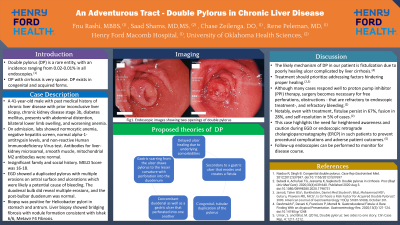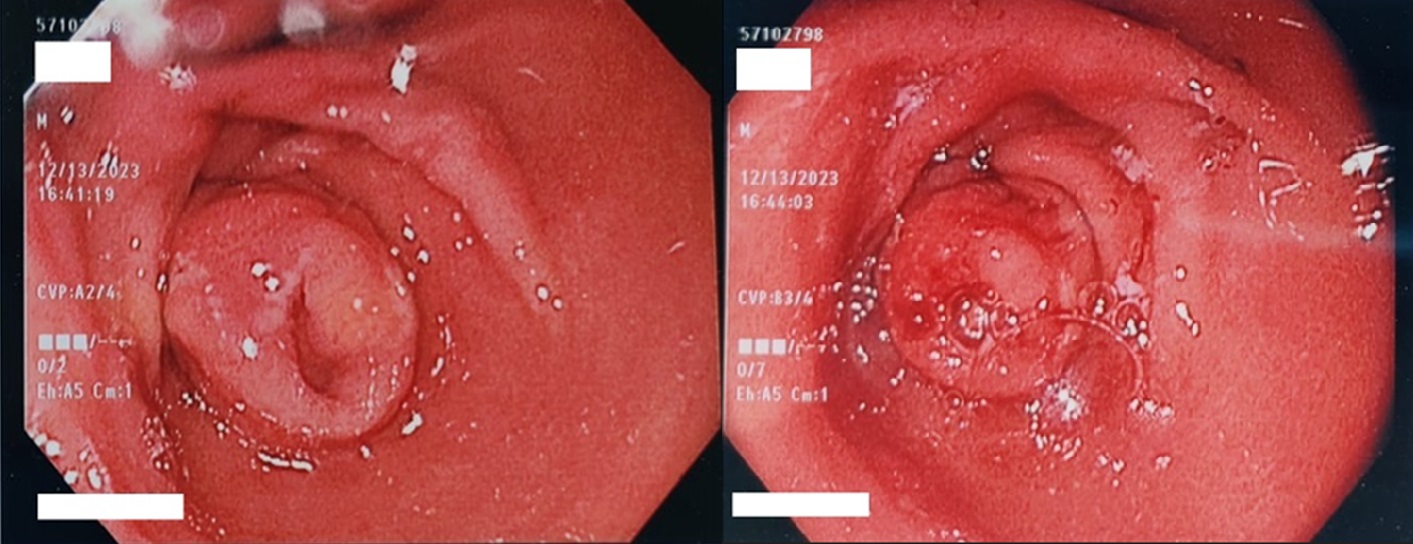Monday Poster Session
Category: Stomach
P3391 - An Adventurous Tract - Double Pylorus in Chronic Liver Disease
Monday, October 28, 2024
10:30 AM - 4:00 PM ET
Location: Exhibit Hall E

Has Audio

Fnu Rashi, MBBS
Henry Ford Macomb Hospital
Clinton Township, MI
Presenting Author(s)
Fnu Rashi, MBBS, Saad Shams, MD, Chase Zeilenga, DO, Rene Peleman, MD
Henry Ford Macomb Hospital, Clinton Township, MI
Introduction: Double pylorus (DP) is a rare entity, with an incidence ranging from 0.02-0.01% in all endoscopies.(1) DP with cirrhosis is very sparse. DP exists in congenital and acquired forms. Research suggests that DP may result from poorly healing ulcers and is linked to comorbidities like diabetes, chronic obstructive lung disease, rheumatoid arthritis, cirrhosis, chronic kidney disease, and radiotherapy.(2,3)
Case Description/Methods: A 41-year-old male with past medical history of chronic liver disease with prior inconclusive liver biopsy, chronic kidney disease stage 3b, diabetes mellitus, presents with abdominal distention, bilateral lower limb swelling, and worsening anemia. On admission, labs showed normocytic anemia, negative hepatitis screen, normal alpha-1-antitrypsin levels, and non-reactive Human Immunodeficiency Virus test. Antibodies for liver-kidney microsomal, smooth muscle, mitochondrial M2 antibodies were normal. Family history was negative for hepato-pancreatic neoplasms, liver disease, and genetic conditions. Social history negative for intravenous drug use, high-risk sexual practices, and travel history. Model for End-Stage Liver Disease Score was 16-18. EGD showed a duplicated pylorus with multiple erosions on antral surface and ulcerations which were likely a potential cause of bleeding. The duodenal bulb did reveal multiple erosions and the post-bulbar duodenum was normal. Biopsy was positive for Helicobacter pylori in stomach and antrum. Liver biopsy showed bridging fibrosis with nodule formation consistent with Ishak 6/6, Metavir F4 Fibrosis.
Discussion: The likely mechanism of DP in our patient is fistulization due to poorly healing ulcer complicated by liver cirrhosis.(4) Treatment should prioritize addressing factors hindering proper healing.(2) Although many cases respond well to proton pump inhibitor (PPI) therapy, surgery becomes necessary for free perforations, obstructions - that are refractory to endoscopic treatment-, and refractory bleeding.(2) Notably, even with treatment, fistulae persist in 67%, fusion in 28%, and self-resolution in 5% of cases.(2) This case highlights the need for heightened awareness and caution during EGD or endoscopic retrograde cholangiopancreatography (ERCP) in such patients to prevent procedural complications and adverse patient outcomes.(5) Follow-up endoscopies can be performed to monitor for disease course.

Disclosures:
Fnu Rashi, MBBS, Saad Shams, MD, Chase Zeilenga, DO, Rene Peleman, MD. P3391 - An Adventurous Tract - Double Pylorus in Chronic Liver Disease, ACG 2024 Annual Scientific Meeting Abstracts. Philadelphia, PA: American College of Gastroenterology.
Henry Ford Macomb Hospital, Clinton Township, MI
Introduction: Double pylorus (DP) is a rare entity, with an incidence ranging from 0.02-0.01% in all endoscopies.(1) DP with cirrhosis is very sparse. DP exists in congenital and acquired forms. Research suggests that DP may result from poorly healing ulcers and is linked to comorbidities like diabetes, chronic obstructive lung disease, rheumatoid arthritis, cirrhosis, chronic kidney disease, and radiotherapy.(2,3)
Case Description/Methods: A 41-year-old male with past medical history of chronic liver disease with prior inconclusive liver biopsy, chronic kidney disease stage 3b, diabetes mellitus, presents with abdominal distention, bilateral lower limb swelling, and worsening anemia. On admission, labs showed normocytic anemia, negative hepatitis screen, normal alpha-1-antitrypsin levels, and non-reactive Human Immunodeficiency Virus test. Antibodies for liver-kidney microsomal, smooth muscle, mitochondrial M2 antibodies were normal. Family history was negative for hepato-pancreatic neoplasms, liver disease, and genetic conditions. Social history negative for intravenous drug use, high-risk sexual practices, and travel history. Model for End-Stage Liver Disease Score was 16-18. EGD showed a duplicated pylorus with multiple erosions on antral surface and ulcerations which were likely a potential cause of bleeding. The duodenal bulb did reveal multiple erosions and the post-bulbar duodenum was normal. Biopsy was positive for Helicobacter pylori in stomach and antrum. Liver biopsy showed bridging fibrosis with nodule formation consistent with Ishak 6/6, Metavir F4 Fibrosis.
Discussion: The likely mechanism of DP in our patient is fistulization due to poorly healing ulcer complicated by liver cirrhosis.(4) Treatment should prioritize addressing factors hindering proper healing.(2) Although many cases respond well to proton pump inhibitor (PPI) therapy, surgery becomes necessary for free perforations, obstructions - that are refractory to endoscopic treatment-, and refractory bleeding.(2) Notably, even with treatment, fistulae persist in 67%, fusion in 28%, and self-resolution in 5% of cases.(2) This case highlights the need for heightened awareness and caution during EGD or endoscopic retrograde cholangiopancreatography (ERCP) in such patients to prevent procedural complications and adverse patient outcomes.(5) Follow-up endoscopies can be performed to monitor for disease course.

Figure: Endoscopic images of Double Pylorus
Disclosures:
Fnu Rashi indicated no relevant financial relationships.
Saad Shams indicated no relevant financial relationships.
Chase Zeilenga indicated no relevant financial relationships.
Rene Peleman indicated no relevant financial relationships.
Fnu Rashi, MBBS, Saad Shams, MD, Chase Zeilenga, DO, Rene Peleman, MD. P3391 - An Adventurous Tract - Double Pylorus in Chronic Liver Disease, ACG 2024 Annual Scientific Meeting Abstracts. Philadelphia, PA: American College of Gastroenterology.

